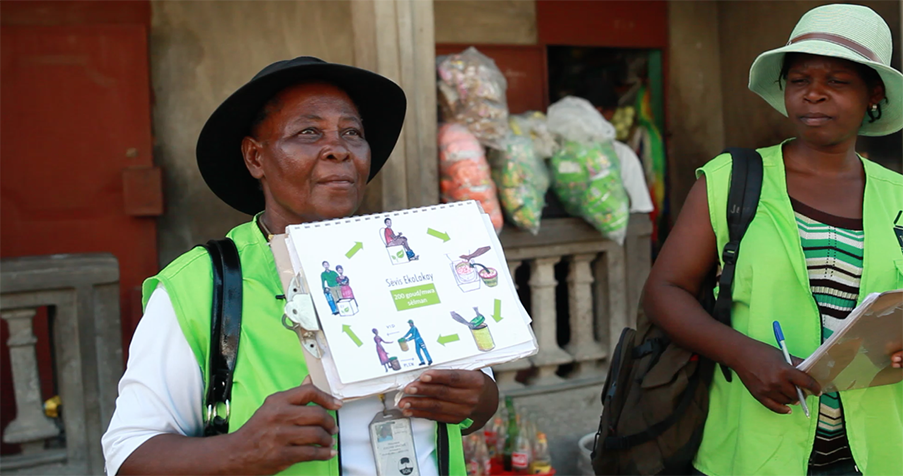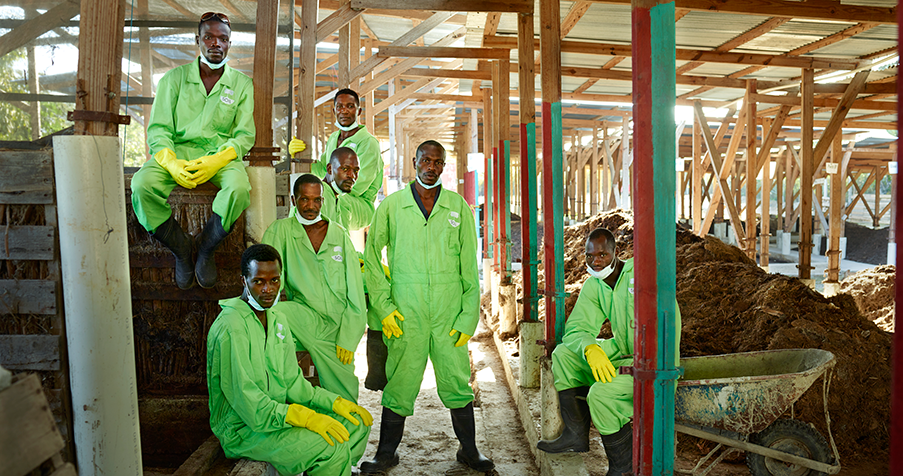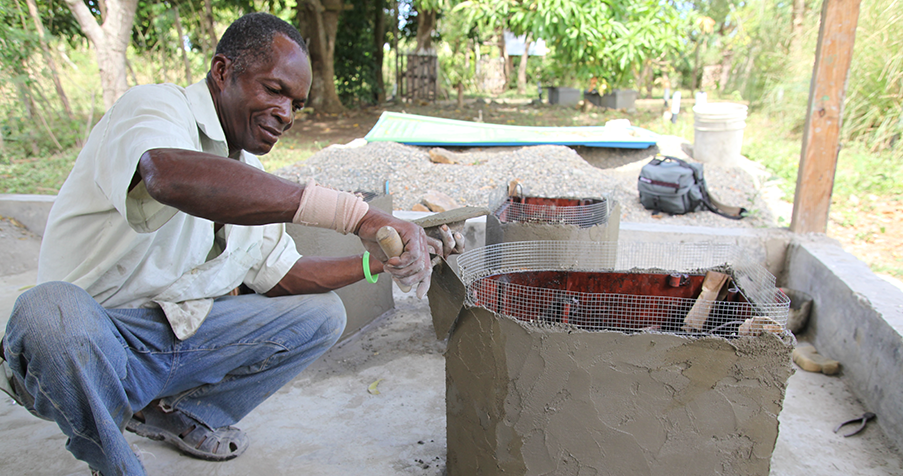Lessons on Restoring Depleted Soil from Haiti
Nov 2 2017
Dr. Kramer is a globally renowned ecologist and human rights advocate who concentrates on the recycling of nutrients in human waste. In 2006, she co-founded SOIL, a social enterprise that promotes dignity, health, and sustainable livelihoods through the transformation of waste into resources. Dr. Kramer completed her postdoctoral research with the Collaboratory for Research on Global Projects at Stanford University, her alma mater. Sasha spends the majority of her time in Haiti.
Swoosh! That’s the sound many of us in resource-rich countries around the world hear at the end of a trip to the toilet. Flush toilets and the “out of sight, out of mind” reassurance they provide to the lucky few with access to sanitation have long been considered the gold standard. However, flush toilets are infeasible for the many densely populated cities, without formal sewerage systems, that are growing rapidly around the world. Equally important, with every flush we miss a vital opportunity to capture valuable nutrients needed to replenish the earth’s much-depleted topsoil—half of which has been lost worldwide in the last 150 years.¹

EkoLakay education in Cap-Haïtien, Haiti. Photo by Monica Wise
Sadly, in Haiti, where SOIL has been working since 2006, a cycle of poor sanitation, environmental degradation, and poverty is evident. In Port-au-Prince, the capital, citywide sewers represent a financial impossibility and waste treatment centers are nearly nonexistent. Haiti inherited a legacy of colonialism and overpowering international intervention that contributed to this lack of infrastructure and continues to affect its people and environment negatively. Once considered the “Pearl of the Antilles” during the French colonial era for its bountiful harvests and fruitful land, Haiti is now a powerful example of the devastating impact of depleted topsoils. Partly due to erosion and depleted nutritional content, just a third of Haiti’s farmland today is truly suitable for agriculture.²
Scientists estimate that Haiti is now losing over 36 million metric tons of topsoil annually.³ By comparison, the United Kingdom loses less than a sixteenth of that.³
Haiti Takes the Lead
The waste from these toilets is picked-up weekly, and—using safe, ecologically-sound methods—turned into compost.
Too often, the story of Haiti begins and ends with the problems facing the country. However, there are stories, largely untold, about the work being done to address Haiti’s interconnected issues and create lasting change. The organization that I co-founded, SOIL, is tackling Haiti’s sanitation and soil fertility crises by pioneering an innovative and earth-replenishing technology that is spreading across the world. Ecological sanitation (EcoSan) solutions capture nutrients that are so often lost with the flush of a toilet, while simultaneously meeting basic sanitation needs in underserved communities. SOIL’s EcoSan toilets capture waste in sealable containers, and 100% of the human waste from SOIL toilets is fully treated, mitigating the public health risks of untreated human waste. SOIL goes a step further than simple risk mitigation by safely transforming treated wastes into organic, earth-restoring compost.

Soil’s Cap Haïtien Composting team. Photo by Chris Buck.
There’s no one intervention that’s a silver bullet to solve the global sanitation crisis—but here’s what sets container-based ecological sanitation solutions apart: they’re remarkably cost-effective, provide dignified sanitation access for families, and ensure that dangerous human waste is safely treated. Adding in resource recapture and waste transformation brings these solutions full circle, allowing human waste to go to work rebuilding Haiti’s depleted soils. In Haiti, several independent reports have found this technology is the best solution for informal urban settlements without established sewage and waste treatment systems.

Construction of EkoLakay toilet. Photo by Vic Hinterlang.
Nutrients by the Ton
SOIL has installed EcoSan toilets in urban communities throughout Cap-Haitien and Port-au-Prince. The waste from these toilets is picked-up weekly, and—using safe, ecologically-sound methods— transformed into compost. SOIL produces over 100 metric tons of agricultural grade compost a year. We sell this compost to Haitian farmers and organizations and use the proceeds to offset the total cost of our sanitation system. When using SOIL’s compost for local production, Haitian farmers have reported a dramatic increase in yields. It’s exciting to consider the potential this could have on food production on a larger scale!
When using SOIL’s compost for local production, Haitian famers have reported a dramatic increase in yields.
Some of the compost we sell is directed to support reforestation efforts in Haiti. Years of deforestation have left Haiti’s mountains prone to mudslides and extreme weather. Building up tree cover in this Caribbean country would better protect it from the effects of tropical storms and hurricanes. We are proud that our compost is also supporting these longer-term climate-resiliency efforts.
To date, we have just over 1,000 families using our EcoSan toilet.
Imagine what we’ll achieve when we expand our sanitation solution to many more households throughout the country! SOIL’s vision is to demonstrate an affordable, dignified household sanitation solution that can, on a global scale, transform a public health hazard—untreated human waste— into a sustainable solution for soil restoration.
For over 10 years, Haiti’s EcoSan solutions have helped mitigate environmental degradation and increased resiliency in a nation poor in resources and vulnerable to climate change. In the process, Haiti has demonstrated to the world that there’s a sustainable way to increase access to sanitation while replenishing the earth’s soil. Those who care about soil health and the benefits it affords humanity should pay attention to the unique sustainable development solutions that sanitation revolutionaries in Haiti are proving possible.
SOIL’S CITED SOURCES
¹Bargout, Remy N., and Manish N. Raizada. “Soil nutrient management in Haiti, pre-Columbus to the present day: lessons for future agricultural interventions.” Agriculture & (2004). UNEP. (2010), FAO (2013), WHO (2012), CIA World Fact Book (2013), Hylkema (2011), UN (2013), WWF (2014), Dragnert (1998), USAID, Food Security 2, no. 1 (2013).
²Hylkema, Amy L. “Haiti Soil fertility analysis and crop interpretations for principal crops in the five winner watershed zones of intervention.” Department of Soil and Water Science, University of Florida (2011).
³Jolly, Curtis M., Dennis A. Shannon, Michael Bannister, Gardy Flauretin, John Dale, B. Alvin, and Pauline Lindo. “Income efficiency of soil conservation techniques in Haiti.” In Proceeding of the 26th West Indies Agricultural Economics Conference: July 2007; St. Augustine, Trinidad and Tobago, pp. 156-163. Caribbean Agro-Economic Society, 2007.
Kulkarni, Chinmaya. “The Implications of Composting Toilets for Nitrogen Flows in Haiti.” Final Report (2009).
Butler J: UK Soil Degradation. Report no 265. 2006, London: The Parliamentary Office of Science and Technology.